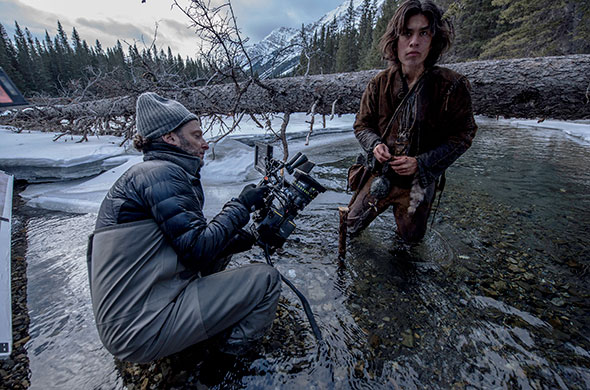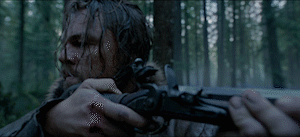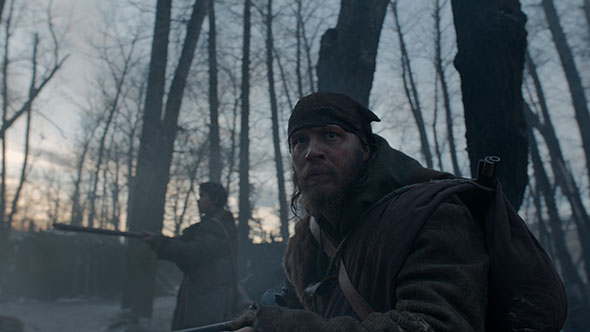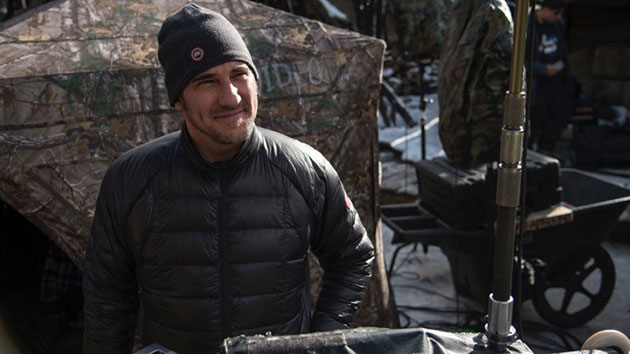Carefully Choreographed Battles, a Menagerie of CG Animals, and Answering the Question: Can a Bear Do That?
Writer-director-producer Alejandro González Iñárritu’s intense survival film The Revenant has been nominated for 12 Oscars. Among those in contention are Leonardo DiCaprio, who has the lead role of Hugh Glass, a fur trader in the 1820s, who is attacked by a bear — a story inspired by true events. The Revenant marks the second time cinematographer Emmanuel "Chivo" Lubezki and Iñárritu have worked together on an award-winning film. Lubezki received an Oscar for Birdman, his second after Gravity. Iñárritu received Oscars for writing and directing Birdman, and the film won best picture.
Artists at Industrial Light & Magic created the bear for The Revenant's pivotal scene, after which his fellow frontiersmen leave Glass to die alone. But that wasn’t the only visual effect in the film. We asked ILM’s Richard McBride [pictured on location at top of page], the overall visual effects supervisor, to tell us more. He received the Oscar nomination for best visual effects along with ILM’s Matt Shumway and Jason Smith and special effects supervisor Cameron Waldbauer.
Studio Daily: Why do you think your colleagues voted for this film to receive an Oscar nomination? Was the bear attack enough?
Richard McBride: I think the bear scene would be the one thing that had the most influence. It’s such a pivotal scene in the movie. It holds a lot of weight as far as its importance in the film. But I don’t think people realize how much more work is in the movie. We didn’t want people to say, "This is an amazing visual effects movie." We’ve done our job concealing it. The best thing about the nomination is that all the artists who worked on this film are getting recognition. Visual effects artists work hard all the time, but this time, they really poured their hearts into it.
What other visual effects did ILM do for the film?
ILM took on some of the most challenging sequences. MPC did the opening battle. Cinesite handled the end battle. ILM did a lot of the other animals: the opening elk hunt, the close up of putting down the elk, the buffalo herd reveal, the wolf pack in that scene, the river sequence, [and] the scene when the horse goes over the cliff.

There are more visual effects than we thought.
Alejandro [González Iñárritu] did not want to reveal too much. He wanted to keep things as much of a mystery as possible. I understand that and am slightly frustrated by it. We like to have people know what our work is, but we also want people to see the movie without knowing which parts are visual effects. We want to help him tell his story and not be visible at all.
So the elk, buffalo, wolves, the horse, the bear, and the bear cubs — were they always CG?
The elk were all CG. The wolves, all CG. The buffalo herd, all CG. The horse was a combination of real, mechanical and CG — I want to respect Alejandro’s wishes and not go into step-by-step details for that. The bear and the bear cubs were all CG. There were quite a few animals. The big challenge, of course, was creating the bear, but we put a lot of details and effort into animation on the buffalo and simulation of the fur, and on developing the wolf pack. We created a hero wolf that didn’t work in the story. Also, another scene cut for pacing.
Did you know going in there would be so much VFX work involving the CG animals?
We knew the animals would all be CG because Alejandro [González Iñárritu] was going to want to tell his story the way he wanted to tell it. It would have been hard to direct real animals the specific and unique way he wanted. Or to explore — to, as we describe it, find the poetry of a scene.
We shot sequentially and, for the most part, received plates sequentially. But there was always some overlap. Alejandro’s style of directing would extend things out.
How did Iñárritu’s style of directing affect the CG work?
Alejandro said to me, “You know, I’ve never directed an animal before.” We had done the opening elk shot, animated it, finished it, and he said he was looking for a different feel to the way the elk were reacting. So, we did another round of animating, approving, and comping. And then he again saw it and came up with another idea. I equated it to the way he worked on set. We had a limited amount of shooting time, so we did a lot of rehearsals, a lot of exploration. When something wasn’t working, we’d try something else. He translated that into the VFX world, which wasn’t efficient. It was tricky. We tried to get him at each step to make approvals, but that didn’t mean he wouldn’t see the scene differently, or want a different feeling in the action that he wanted to try. Fortunately, he was also the producer.
Were you on set during filming?
I was on the original location scout, and then in the different locations. The Canadian Rockies in Alberta for the most part, then the Squamish area of British Columbia where we filmed the bear sequence and did some work on the river, as well.
How cold was it?
It got so cold that they had to shut down production at one point. It was 30 below. They had to pause and rethink and regroup. The locations were very much a challenge as well as getting into the remote places.

DP Emmanuel Lubezki (left) and actor Forrest Goodluck shooting on location.
What did you do on set?
Alejandro was always looking for something to challenge how he was going to tell the story. All the heads of the departments were available all the time to help him explore something new.
I was there for any scenes coming up that were going to involve visual effects, which were more than I probably expected. There were the known defined scenes, and then there were the scenes that they figured out. They took a lot of their work from what they discovered creating Birdman with a single camera move — a way to continue the story, to immerse the audience in a moment. So they did long camera takes as well as wanting to join and stitch takes together.
We would need to maintain continuity between days and takes. We might have clouds one day or sun breaking through the clouds, and the next day the clouds would be completely different or the lighting slightly different. We might have snow one day and not the next. We had to make a take feel like it was in the same moment as the next take.
What did you do on set for lighting reference and to help blend takes later in post?
We shot a lot of plates of skies. Lots of environment spheres. We did the standard gray and mirror balls, but only on scenes with the CG animals. The animal wrangler John Scott had brought a buffalo on set so we could get lighting reference. And Andrew Simpson of Instinct Animals, who handles the wolves for Game of Thrones, brought out his wolves. For the bear attack we had the bear pelts Leo [Leonardo DiCaprio] wore in the film and used those for lighting reference. It was difficult to get the animals out there on location, but for the reveal of the buffalo herd and the wolf pack we were lucky to have those trainers available. Of course, the animals were more used to the weather than we were.

OK. Let’s talk about the bear. Did you work from previs for the bear attack?
We did not do previs. The equivalent of previs for Alejandro was rehearsal. We also had hours and hours of reference. Alejandro and Chivo [Lubezki] found a video on YouTube. Someone had fallen into a bear enclosure in a large habitat in a zoo and someone filmed the bear’s attack with a camera phone or something like that. It was really uncomfortable to watch. But there were disturbing moments that Alejandro and Chivo really liked. It was a single camera take that lasted a long time and prompted the idea to have the audience completely immersed in the moment once we got into the attack itself. So we had that and a lot of other reference. We worked with the stunt team on how to move Leo around and from there it was working with Chivo and Alejandro to choreograph the camera work and piece the reference moments together.
Then it was almost like rehearsing for a live performance. We initially did that with a small camera crew. We had an Alexa camera and did a video tap to get everyone on the same page. That helped all the departments plan how they were going to piece everything together. Put the makeup on. Progress the ripping of the costume. Beat by beat. We started in the summer and we shot in October. By the time we were shooting on the day, we had a really good idea about what we were going to do.
What did the animators use for reference?
We based all the motion of how the bear was affecting Leo on video documentary reference. We matched our bear’s motion into Leo’s motion. The stunt team was involved in getting Leo to move around, but he performed all the action for the most part.
We had to sell every single moment to Alejandro based on reference that was real. He’d ask, “Can a bear do that?” And we’d say, “Yes, here’s that moment.” We pieced hundreds of small clips together. The animators would do their own edits of the reference and then tie everything together. We could match every nuance. Every footfall. Every lip curl. We’d watch the reference over and over to fit it with Leo’s performance. There’s no escaping a camera that close.
Can you give us an example?
The shot when Leo is pinned and the mother bear puts a paw on his head; steps on his head. The camera looks at the bear. Leo is playing dead. The bear looks to see if he is still a threat to her or her cubs. We didn’t call it emotion. It’s a bear being a bear. She isn’t angry. She’s agitated by the circumstances. She steps, looks up, looks around. She’s more concerned with her cubs. Alejandro says, “He’s nothing to her. He’s like a piece of chicken or meat.”
So how do you sell that? With detail and nuance. Subtle things you might not pay attention to but that needed to be as natural as possible. Things that felt like an accident. The head swinging. Subtle motion in the snout. There are a lot of nuances in the snout. The bear is expressive in the way she’s smelling, using her nostrils and mouth to take everything in. So we had a lot of that detail. No frowning or scowling. If we made her look angry or scowling, that’s where it would break. We had subtle motion in the shape of her eyes and where she’s looking. Her head does something simple. Checks the prey underneath. Of course, the call from her cubs in the background prompts her to move away from him.
Were there technical challenges with the bear?
The fur. Fur is always a challenge, especially seeing it that close. It has some wetness. There’s a lot of debris caught in it. So we had a lot of artistic detailing and nuance. The bear team studied and matched reference and looked at the environment. They had to mix in blood and wetness from the rainfall. It definitely pushed the pipeline at ILM quite a bit. We discovered some new techniques for creating a detailed groom and translating that into the motion and simulation of the fur. For the bear, we had multiple levels of simulation — skeleton, muscles, fascia, skin, fur. We’re not as close to the bison and wolves, so creating their fur was simpler, but we still had the combination of muscle, skin, and fur simulations. For the details on that, you’d need to ask Jason Smith, our in-house visual effects supervisor.
How long did it take the crew to create the bear attack?
The plates were turned over in mid-December [2014]. Then we had a lot of tracking. The shots were so long it took a long time in the layout department to get the scene built and pieced together. Meanwhile, the animators were blocking in the action. Alejandro was involved every step of the way. The animation took longer than we anticipated because of all the details, of course. We delivered the final shots in April [2015]. So eight to nine months [total].
How many people were on the crew at ILM?
We had probably around 100 total, 55 in San Francisco and 49 in Vancouver. It went up and down, with people in and out, but we had a fairly lean crew.
Tell me about the other nominees from ILM.
Matt Shumway led the team of animators who were primarily in the Vancouver studio. They were the team breaking down the nuances of motion and pushing to find the reality in every step, every eye blink, every nostril motion. They immersed themselves into creating the reality Alejandro was looking for — a real bear, not a movie monster.
Jason Smith was the in-house visual effects supervisor. He had come off working on Warcraft and has a CG and creature background. He’s savvy with the pipeline and working with the creature team getting the fur grooming and working with the artists to get those nuances.
And the other studios that worked on the film?
Notably, the opening battle sequence created by MPC was quite a challenge because it was such a ballet of violence choreographed to have overlapping action with multiple plates stitched together. It was shot over two weeks, so there were a lot of continuity issues. Every animal had to live within these naturalistic plates and lighting. Every weapon and arrow had to be as believable as every moment with our main actors. Everything needed a purpose. Alejandro didn’t want random action. It was very well choreographed. The visual effects had to be as seamless as everything else.
Cinesite did the end battle that was shot in Argentina with Tom [Hardy] and Leo. Again, they had multiple plates shot on multiple days in constantly changing weather, so it was another one with continuity issues, and tricky, with a lot of blood and weapons added as well.

Actors Will Poulter (background) and Tom Hardy.
What did you learn from working on this film?
I learned a whole different approach to the creative process and a new appreciation for that process, which is something I don’t think many other filmmakers would even be allowed to attempt. The way they explored on set was fascinating to me. The standards they set for telling the story was one of the most mind-blowing parts. How are they going to propel the story? How are they going to tell the story? I would see something and think it was amazing. They would say it was terrible. And they’d do it all over again. Watching how they discovered their story and told it was something I could never have expected. I was learning every day. Seeing how they discovered the poetry.
The last film you were on was unique, as well. How did working on this film compare?
I didn’t think I would ever get another amazing experience like Gravity. The common thread is working with Chivo. On both films, the filmmakers had a high standard of pushing the work and using visual effects and looking for something unique, true, poetic in telling the story. It is amazing to be part of the process with these filmmakers. Very challenging, but extremely rewarding. You know you’re working on something that hasn’t been seen before.
The Revenant was the hardest film I’ve ever worked on. The locations. The production itself. The weather. All those things played into it. And Alejandro was definitely a challenging director to work with. He was critical of everything he was doing and of all the departments contributing to the film. But I loved it. It was one of those projects VFX artists live for.
Crafts: VFX/Animation
Sections: Creativity
Topics: Project/Case study Q&A ILM oscars 2016 richard mcbride
Did you enjoy this article? Sign up to receive the StudioDaily Fix eletter containing the latest stories, including news, videos, interviews, reviews and more.











Leave a Reply